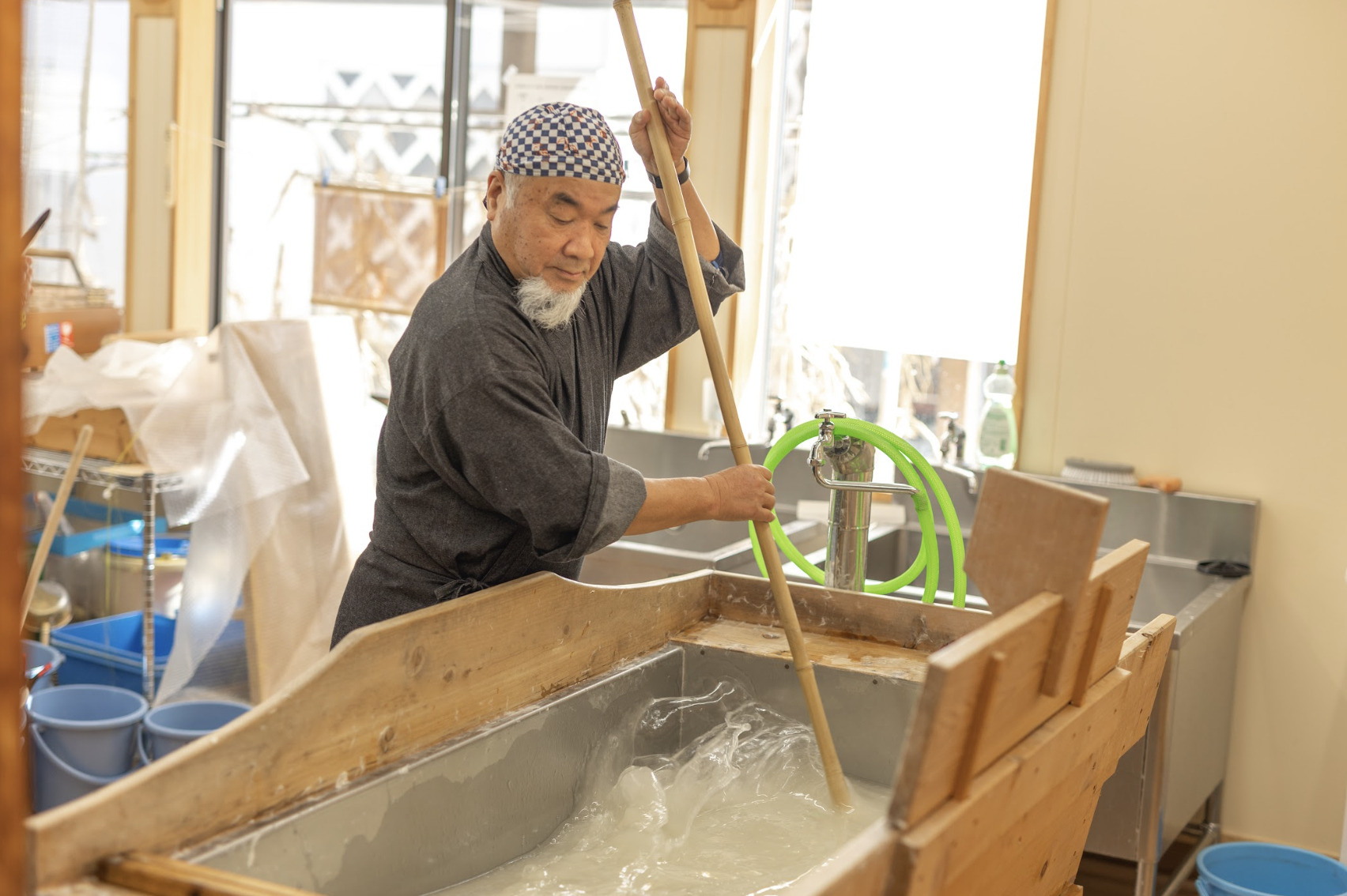
Growing Trees, Crafting Paper, and Connecting Bonds: The Tradition of “Washi” and “Mizuhiki” in Iida, Nagano

羽場竜也・関島直人
Ryuya Haba・Naoto Sekijima
Iida [Nagano]
Ryuya Haba
Serving as the secretary-general of the Hisakata Washi Association, Haba Tatsuya is dedicated to preserving and promoting the traditional craft of "Hisakata Washi" in the Shimohisakata region of Iida City. Actively engaged in activities such as educating local children and residents about the allure of washi papermaking and spearheading the development of new products, Haba is a driving force in the community.
Naoto Sekijima
Inspired by the dedication of his father and older brother, Masahiro, to the traditional craft of "Iida Mizuhiki," SEKIJIMA Naoto embarked on the path of Mizuhiki. Currently serving as the managing director of the "Sekijima Mizuhiki Store," founded by his father, Sekijima is actively involved in global initiatives, including hosting workshops for foreign tourists and collaborating with foreign embassies.
Located south of Nagano Prefecture, in the district of Shimohisakata in Iida City, conditions favor the cultivation of robust kōzo trees, making it an ideal environment for traditional washi paper production. Additionally, this region has seen the flourishing of traditional crafts utilizing washi, with Mizuhiki, a decorative cord used in engagement ceremonies and ornaments, gaining prominence. In this interview, we speak with Haba Tatsuya, the secretary-general of the Hisakata Washi Association, and SEKIJIMA Naoto, the managing director of Sekijima Mizuhiki Store, to delve into the intertwined traditions of two cultural treasures in a single community.
“Hisakata Washi” and “Iida Mizuhiki”: Two Inseparable Traditional Crafts
In the city of Iida, the legacies of “Hisakata Washi” and “Iida Mizuhiki” have been passed down through generations. Why does this small region boast two distinct traditional crafts? To unravel the intricacies of their relationship, let’s first delve into the words of the key figures behind each craft.
Haba Tatsuya, the secretary-general of the Hisakata Washi Association, sheds light on the resilience and practicality of the washi paper produced in this region: “The washi paper crafted here possesses strength and practicality, making it suitable for various situations. For instance, items like the ‘Moteyui,’ used to fasten hair, are created using washi from the Shimohisakata district. The robust and beautiful Moteyui from Iida gained acclaim nationwide, becoming highly valued in places like Edo’s Ryogoku Sumo and Yoshiwara’s Karyukai(world of the geisha).”
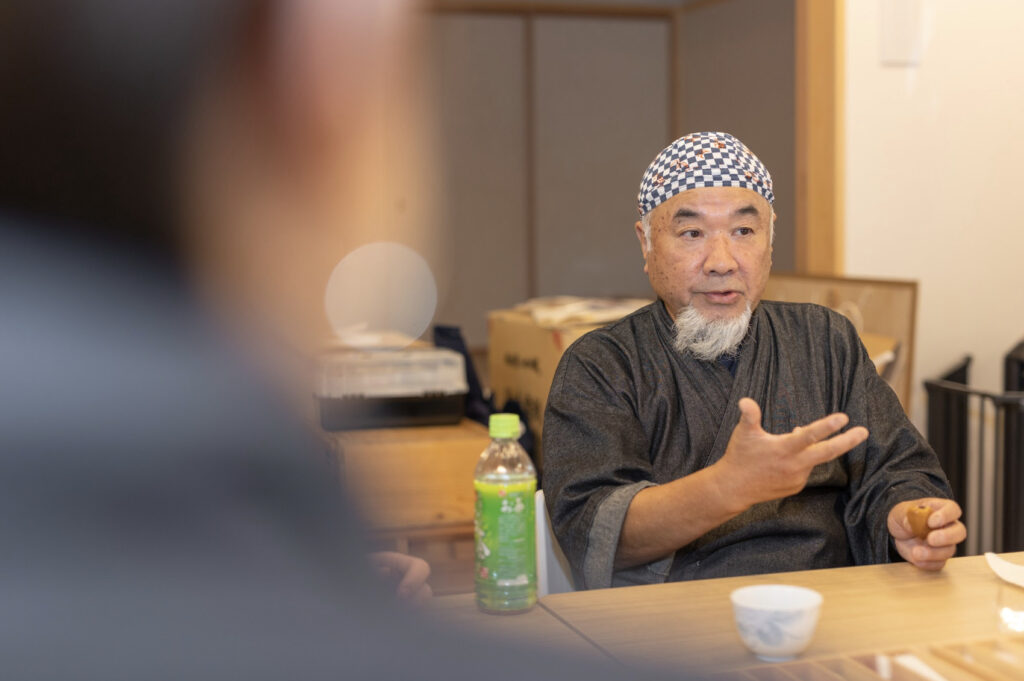
However, with the onset of the Meiji era, the government issued the Decree on Men’s Hairstyle, leading to the abolition of the traditional Japanese hairstyle known as “chonmage.” In tandem with this shift, the culture of Moteyui also declined. In its place, the expertise in Moteyui was repurposed for the flourishing production of “Mizuhiki,” used in engagement ceremonies and decorations.
“In this region, there has been a well-regarded tradition of using high-quality washi paper. Leveraging the advantage of having such a material available, various artisans dedicated themselves to Mizuhiki production. Presently, Iida proudly holds a 70% share of Mizuhiki production in Japan,” SEKIJIMA Naoto of Sekijima Mizuhiki Shop, which connects the tradition of Iida Mizuhiki, speaks.
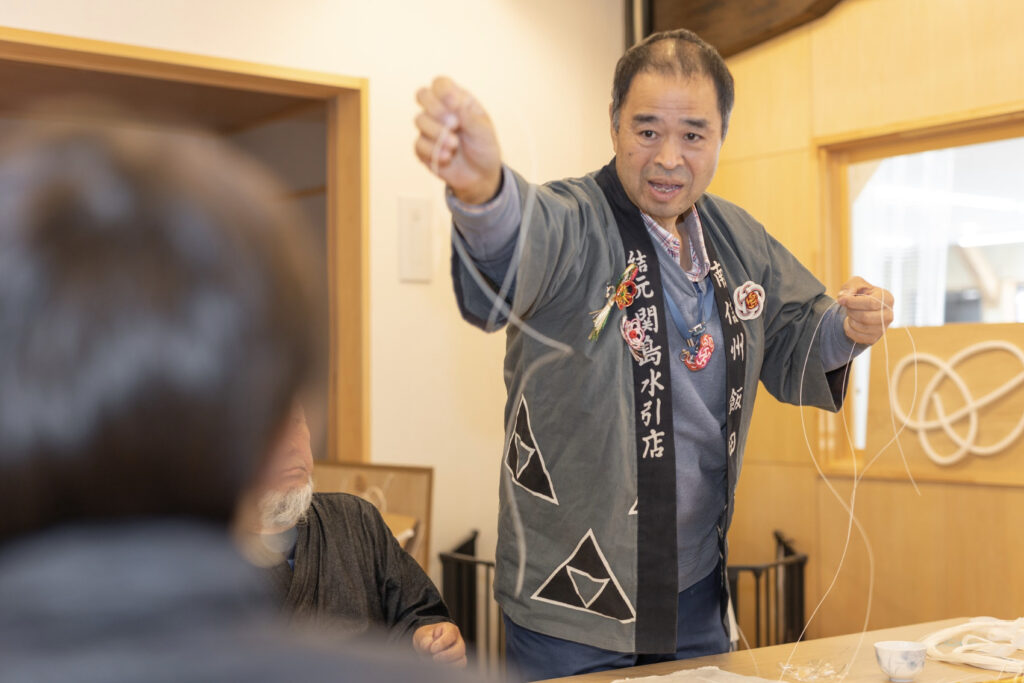
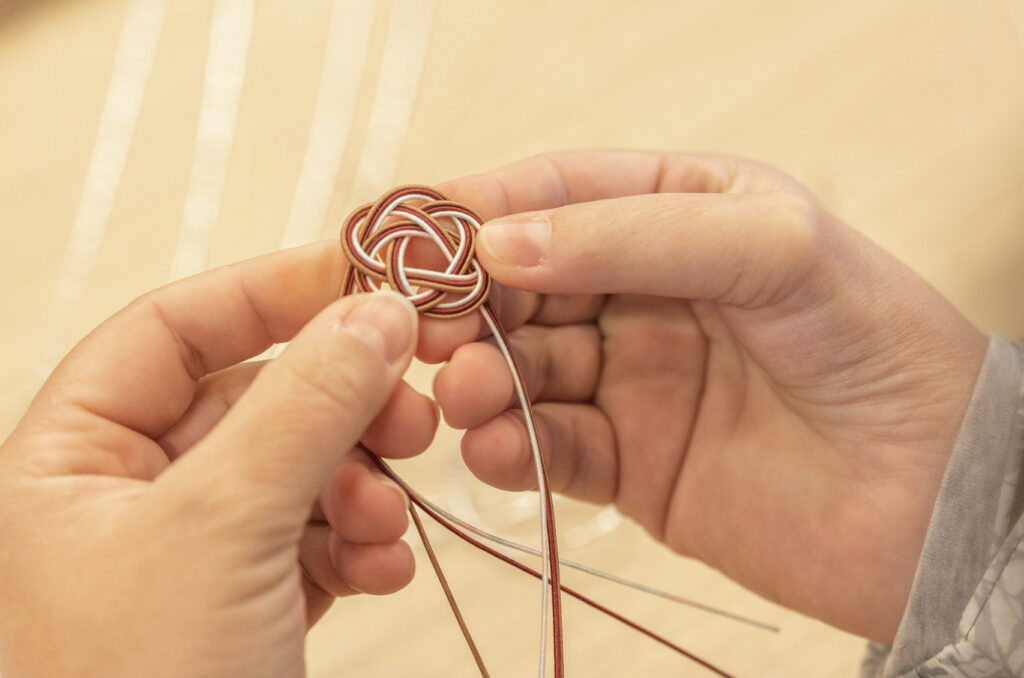
Manufacturing that utilizes the local climate and carries the history of the region
Two individuals serve as the linchpins of local tradition. How did these “connectors” find their way to this path?
Haba Tatsuya, originally active as the community center director in the Shimohisakata district, was drawn into the initiative of the “Hisakata Washi Association,” a group dedicated to preserving local traditions. Reflecting on his journey, Haba shares, “I had never been involved in washi papermaking before. However, once I got involved, I found it to be profound and fascinating. The subtle variations in expression with each papermaking technique, the joy when you successfully create a beautiful texture – I became captivated by the charm of washi paper.”
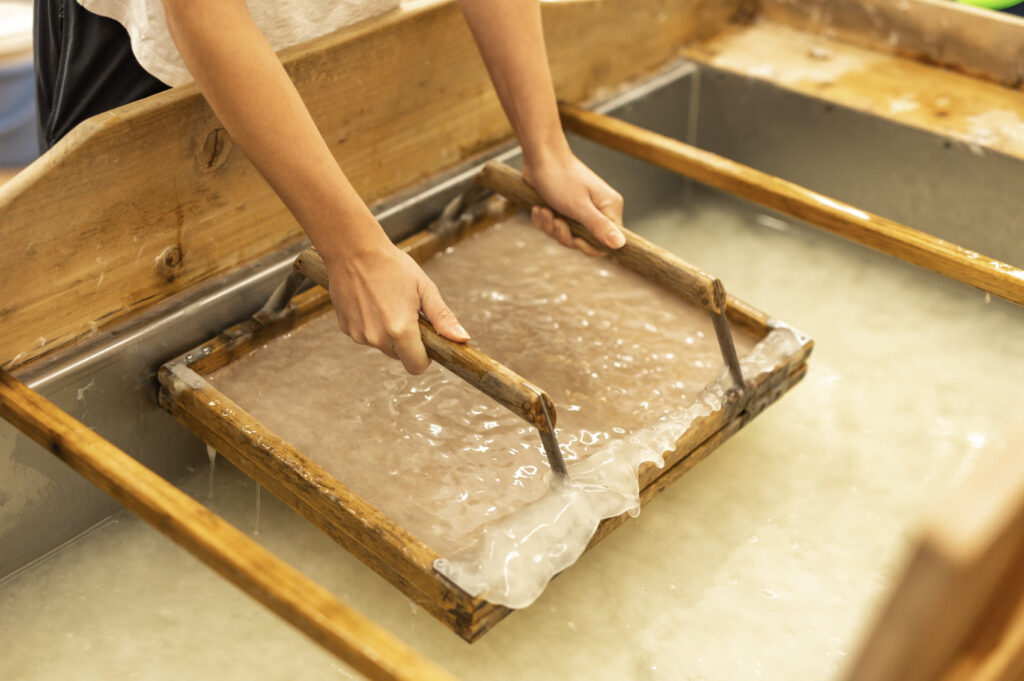
After undergoing training, including a period of apprenticeship in the renowned washi-producing city of Mino in Gifu Prefecture, Haba became a seasoned washi artisan in the Shimohisakata district. Today, he leverages the unique characteristics of the region, focusing on the entire process of washi paper production from raw materials.
“The Shimohisakata district features numerous south-facing slopes, providing an abundance of high-quality water, an inland dry climate, and the ideal conditions for the growth of trees known as ‘kōzo.’ These regional attributes have played a crucial role in the continuity of the washi papermaking culture. It’s not just about honing the technique of papermaking; one must also acquire the wisdom to cultivate high-quality kōzo trees,” explains Haba.
Washi paper is made by spending a year growing kōzo trees, peeling the bark, pounding it into fine pieces, and then making the paper. “It is a process that involves many steps, but it all starts with the raw material, the kōzo tree.”
Today, several kōzo trees planted by Mr. Haba are growing in the fields of the Hisakata Washi Association.
SEKIJIMA Naoto’s father is the founder of the Mizuhiki store. Growing up watching his father’s back, Sekijima himself was attracted to the world of Mizuhiki.
“I grew up in an environment where Mizuhiki was always present since childhood. Observing my father’s dedicated approach to his work, I found it admirable, and naturally, I gravitated towards the world of Mizuhiki,” shares Sekijima.
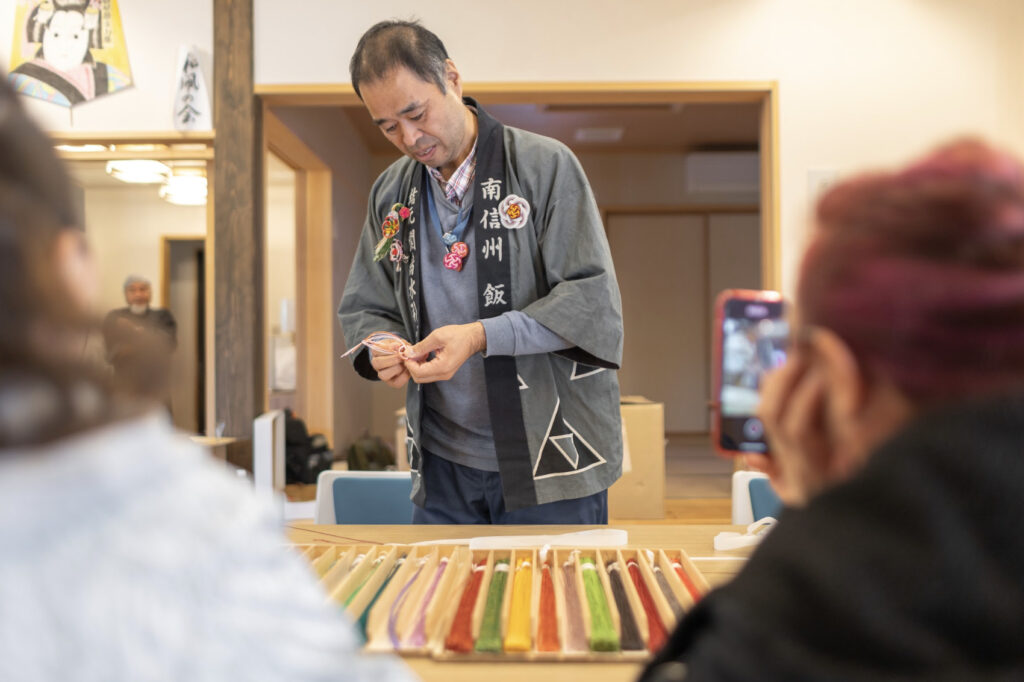
While Mizuhiki is often utilized as a decorative element, Sekijima discovered various possibilities within the craft as he delved into his work.
“Many instances involve Mizuhiki in scenes where people give gifts or celebrate something. We say we ‘tie’ Mizuhiki when creating products, and through this ‘tying,’ connections with people can also be formed. Personally, my engagement with Mizuhiki has led to encounters with people from around the world,” explains Sekijima.
He has actively organized workshops for foreign tourists and pursued international expansion, achieving recognition such as winning the COOL JAPAN AWARD in 2019.
Amidst the changing times, the mission to pass down the “treasures of the community” to the next generation becomes crucial.
Since the Meiji era, machine-made Western paper, which is inexpensive and produced in large quantities, has become widely available, leading to a decline in the use of traditional washi paper. In the Shimohisakata district, it is said that during its peak, approximately 223 out of around 300 farming households were engaged in washi papermaking. However, this number gradually decreased. Adding to the challenges, in the 1960s, a typhoon wiped out the kōzo trees, the raw material for washi, and for a while, there were no farming households producing washi in the region.
“It was undoubtedly a challenging time for washi paper in the Shimohisakata district. However, residents of the region and former farming households engaged in washi production stood up, questioning whether it was acceptable for the local traditional culture to fade away. They established the ‘Hisakata Washi Preservation Society’ (now the ‘Hisakata Washi Association’) to revive the traditional craft. I feel a responsibility to carry on the sentiments of the community,” explains Haba.
Currently, Haba actively cultivates kōzo trees, offers washi papermaking experiences to tourists from both within and outside the country, and creates opportunities for elementary school students to make graduation certificates with washi paper. His energetic efforts are aimed at ensuring the continuity of washi paper culture for the next generation. He expresses, “I want people to savor the unique texture and warmth that can only be found in handmade creations from around the world.”
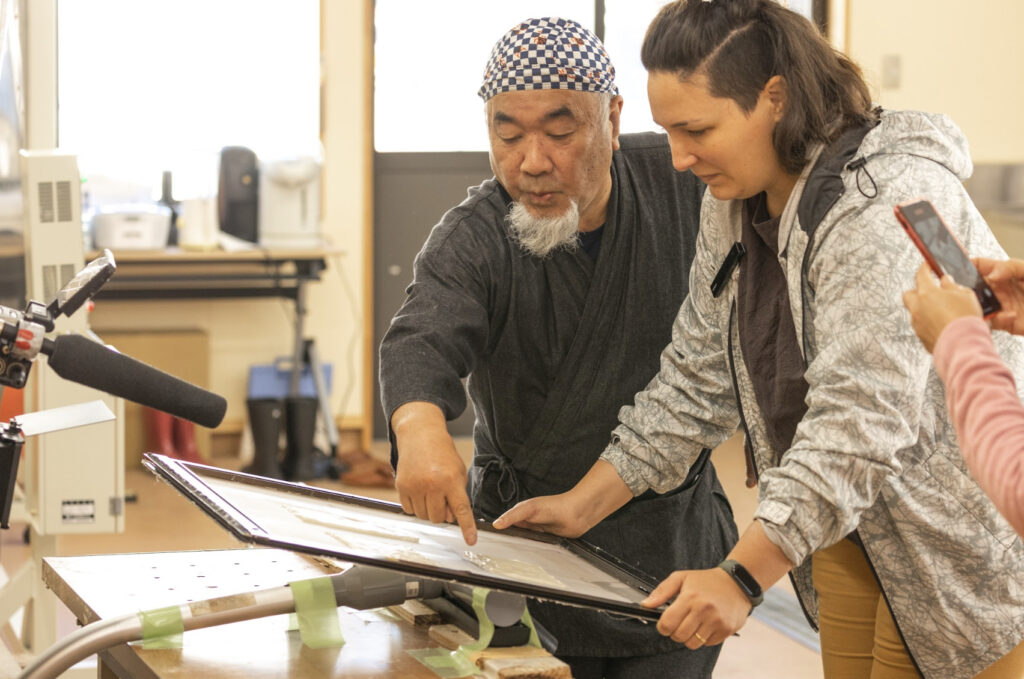
The desire to preserve the region’s traditional culture is a shared sentiment for Sekijima Naoto as well.
“The Mizuhiki industry has deep roots in this area, spanning over 450 years. I want to ensure that this enduring culture is passed down to the future without interruption. In the near future, the Linear Chuo Shinkansen is set to open in the Iida region. With improved accessibility from urban areas like Tokyo, I hope to leverage this advantage and increase opportunities for people to see, touch, and experience Mizuhiki. Choosing colors from the hundreds of Mizuhiki variations, combining them, shaping them— I want more people to savor the culture of intricate knotting,” says Sekijima.
Not only does he aim for more people to experience Mizuhiki, but Sekijima himself is embarking on new challenges to explore the potential of Mizuhiki.
“In Japan, Mizuhiki is commonly associated with weddings, often used for wrapping money gifts. However, Mizuhiki has the potential to extend beyond these limited situations, becoming items that can be used in everyday life, such as earrings, clothing, or wrapping. I believe it is our role to pave the way for such possibilities and expand the horizons of Mizuhiki,” expresses Sekijima.
Finally, I asked them about what he wants to connect in the future.
“Hisakata Washi” and “Iida Mizuhiki” are treasures of Iida. By collaborating these two traditional crafts that have been nurtured as part of the local cultural heritage, we aspire to connect together the memories, craftsmanship, and sentiments of this region of the future.
